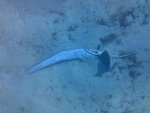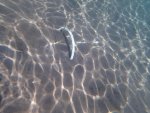vyv_cox
Well-known member
Vyv, are you suggesting that a Rocna that has plowed a trench and piled up sand ahead of it is not well set or just that it was difficult getting it to set ?
I am used to seeing the Rocna set in its own length, with a scar maybe 40 cm or not much more. In the case of the Amorgos episode we knew it was dragging as we were trying to set it, chain bouncing and transits moving, but I persevered because I was expecting this to be a difficult place. I was using more chain than normal, maybe 35 metres in around 5 - 6 metres depth for the same reason. Eventually we held and I increased revs more than I would normally. Once I swam to it I could see that the scar was maybe 10 metres and the anchor was largely on the surface as shown previously, with a mixture of sand and weed in a pile ahead of it.
Jonathan's question re the June anchoring - my Rocna is 15 kg. One of the other boats is a HR34 known to us, Bugel about the same size as ours. The other two boats were rather bigger, so I suspect their anchors were also. The Delta was barely set at all, lying on the surface. They made no attempt to reverse it in and very quickly after anchoring swam ashore with their dog and walked along the beach. Brave indeed.






